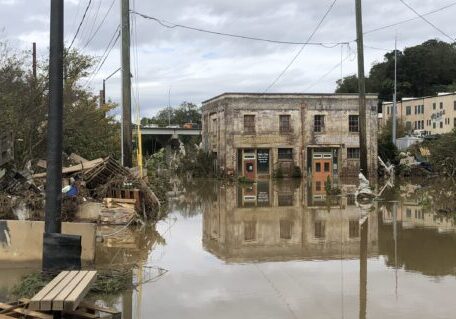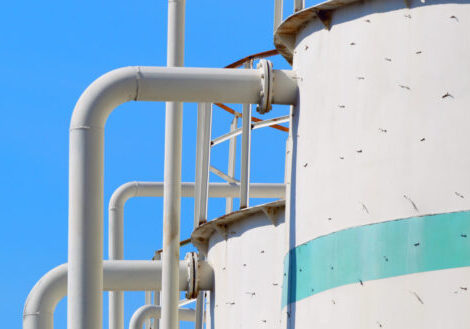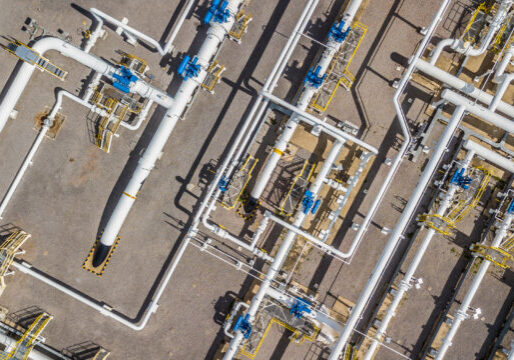October 1, 2025
Green hydrogen and ammonia are making waves in the shipping industry; will they do more harm than good?
By Eva Morgan
In early March, a large ship made its way into Southampton’s port on the south coast of the UK. A green circle and the words “leading the way to real zero” plastered on the side sent a message: this isn’t your average ship.
Named “Green Pioneer” and owned by Australian mining and green hydrogen giant Fortescue, the ship is a demonstration project seeking to show the world that sea vessels can run on ammonia.
Ammonia has been used for over a century as a crucial ingredient in fertilizers, but the shipping industry is now turning to it as a potential alternative fuel, in part spurred by the International Maritime Organization’s carbon reduction goals.
Ammonia is easier to liquefy and store compared to hydrogen, and ships have been carrying it as cargo for decades, making it an attractive solution to the industry’s current reliance on fossil fuels. Maritime shipping is a heavily polluting industry, resulting in over 850 million metrics tons of CO2 in 2022 and causing an estimated 84,000 – 103,000 premature deaths from fine particulate matter (PM2.5) exposure in 2015.
Ammonia is produced by combining hydrogen with nitrogen from the air, a process that usually uses grey hydrogen made from fossil fuels, resulting in a product tied to a very large carbon footprint. The key to a “real zero” fuel, according to Fortescue, is replacing the grey hydrogen with green hydrogen, created with just water and renewable energy, to make green ammonia.
Ammonia as a fuel
There are a few potential ways to extract energy from ammonia. The first is “cracking” the ammonia back into its nitrogen and hydrogen components and then burning the hydrogen – essentially using ammonia to store and transport hydrogen. The second is to run either ammonia or hydrogen through a fuel cell, though the former isn’t commercially feasible just yet. The last way is to burn the ammonia directly. While seemingly straightforward, ammonia burns slowly and doesn’t ignite easily, requiring the use of a “pilot fuel” to be blended with it.
Fortescue and the Green Pioneer went with the latter method, creating what they claim is the world’s first dual fuel ammonia and diesel ship. Two out of the four diesel engines onboard were retrofitted to be able to run on a blend of ammonia and diesel, although chairman and former CEO of Fortescue Andrew Forrest claims that future ships will run on ammonia only.
Is green ammonia actually low carbon?
The idea that green ammonia is low carbon is predicated on the low carbon status of the green hydrogen used to produce it. Green hydrogen is touted for its climate benefits, but it requires massive amounts of renewable energy for production, directing it away from other more beneficial decarbonization needs. Hydrogen itself is an indirect greenhouse gas when leaked into the atmosphere, prolonging the lifetime of atmospheric methane, which is a more potent greenhouse gas than carbon dioxide. Additionally, large amounts of freshwater are needed in green hydrogen production, putting more stress on drought prone regions.
The climate and environmental concerns related to green ammonia don’t end there. When ammonia is burned directly, as in the Green Pioneer, both nitrogen oxides (NOx) and nitrous oxide (N2O) are emitted. NOx is a potent air pollutant that leads to the formation of fine particulate matter and ozone, wreaking havoc on the respiratory and cardiovascular systems of those nearby. N2O is an oft forgot greenhouse gas, almost 300 times more powerful than CO2. To learn more about the climate impacts of using green ammonia as a shipping fuel, see CEG’s factsheet The Problem with Green Ammonia.
Ammonia leaks during every stage of the supply chain, including combustion, and escaping molecules are difficult to track. In fact, research has shown that ammonia leakage from industrial plants was vastly underestimated. Ammonia leaks are harmful, contributing to additional PM2.5 and ozone formation.
Through increasing nitrogen levels, ammonia leaks and emissions from NOx and N2O can also devastate ecosystems leading to biodiversity loss and eutrophication.
The final nail in the coffin for ammonia combustion is the need for a pilot fuel, likely fossil fuel based, that will come with its own emissions and environmental impacts. Typically, Green Pioneer only uses 30 percent ammonia in its dual fuel engines, relying on diesel for most of its energy, though it has gotten up to 70 percent ammonia at times.
Production delays and building momentum
Southampton is just one of the ports slated to be visited by the Green Pioneer, which took off from Singapore in January. This global tour is meant to show that ammonia can be safely stored and combusted on a ship, with the ship being inspected and reviewed at each port.
Safety challenges have been rumored as reasons for delays of other ammonia-as-a-shipping-fuel projects. Ammonia is extremely toxic, and a small leak could have serious implications for workers and surrounding communities, with concentrations above 2,500 parts per million being fatal in about 30 minutes, and lower concentrations leading to respiratory issues and burns. Ammonia is also corrosive, and while ships have been transporting it as cargo, using it as a fuel requires extra components and safety protocols. The International Maritime Organization recently responded to the need for more regulation with interim guidelines on safely using ammonia on board.
Despite the extra caution needed, companies are taking note of the expanding industry and launching their own projects. In China, the first ship using certified green ammonia set sail in July (Green Pioneer was, somewhat ironically, fueled with grey ammonia). Amogy, a Brooklyn-based start-up, is working on technology to “crack” ammonia fuel back into hydrogen and nitrogen to then burn the hydrogen as fuel. They’ve converted a sexagenarian tugboat to run on their system. Many more companies are jumping on these opportunities, with demonstrations showing ship to ship transfers, ammonia powered two-stroke engines and talks of a container ship.
Building out a polluting industry
Despite all the hype around green ammonia, increasing production could very well lead to more emissions and the devastation of the already unbalanced nitrogen cycle. There is also a question of whether the ammonia will even be produced using green hydrogen, as a recent estimate suggests that in 2050 less than 1 percent of the global hydrogen market supply will be from renewables.
Decarbonizing shipping is a daunting task, made slightly easier by the fact that 40% of current shipping by weight is fossil fuels. As we continue to decarbonize other industries, long haul shipping will be in less demand and consequently, the need for shipping fuels will be too. Batteries and wind are also putting in the work, both successfully powering cargo ships in the past few years.
Long-haul shipping may still require some fuel, whether it be green ammonia, green hydrogen, methanol, or biofuels. But as massive industry lobby groups still push for LNG as a clean transition fuel (spoiler alert: it isn’t), increased scrutiny should be placed on these combustible solutions to make sure they aren’t getting in the way of greener, cleaner, options.














